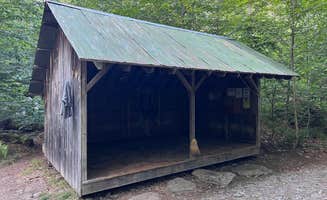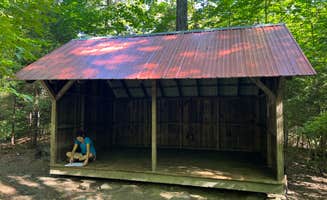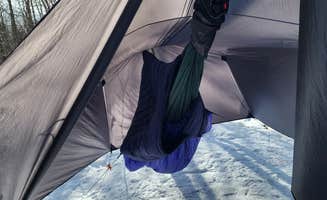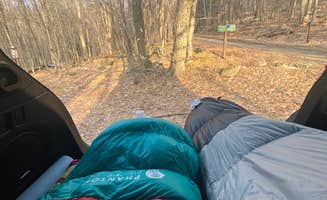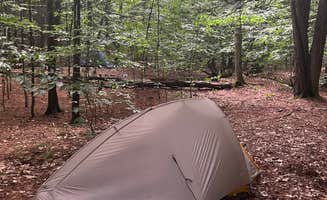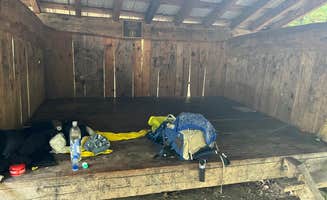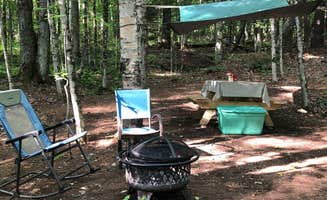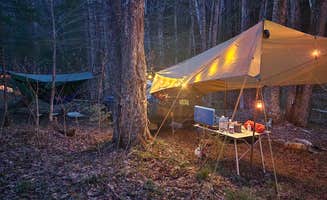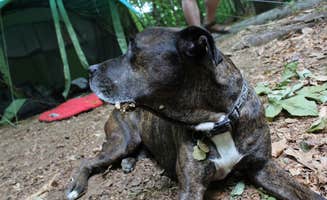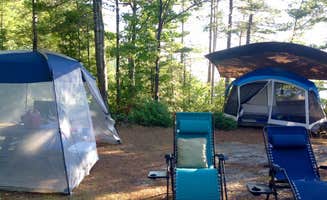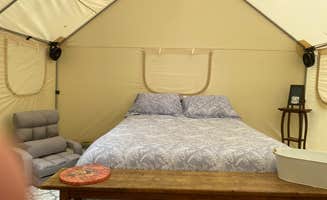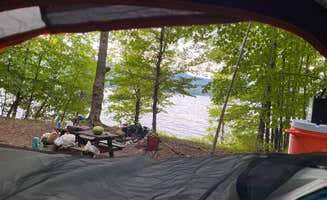Tent camping areas near Ludlow, Vermont provide access to the Green Mountain National Forest through a mix of primitive backcountry sites and Appalachian Trail shelters. Most require moderate to difficult hiking access with limited facilities. The region connects to major trail networks including the Long Trail and Appalachian Trail with elevations ranging from 1,200 to 3,500 feet. Winter camping requires specialized cold-weather gear while summer nights remain cool at higher elevations.
What to do
Swim in forest ponds: Little Rock Pond Group Camp & Shelters offers excellent swimming opportunities. According to Meredith C., "The pond is surprisingly warm for its altitude and it's home to two Common Loons. There's a huge jumping rock on the far side of the pond."
Explore multiple trail systems: Stratton Pond Shelter provides strategic access to multiple trail networks. Miccal M. notes, "The lake looks great and is one of the largest bodies of water on the Long Trail."
Winter camping and snowshoeing: Michigan Brook Road camping areas remain accessible year-round with proper equipment. Keegz M. explains, "If you would like to continue down the service road during winter months I would highly recommend snowshoes or a snowmobile."
Find swimming holes along streams: Beyond established ponds, local streams offer cooling spots. Justin P. reports at Stony Brook Backcountry Shelter, "There was plenty of water at Stony Brook / Mink Brook a bit further northbound. I only explored a bit offtrail down the brook but found a decent swimming hole (could just barely submerge myself) to clean off a bit."
What campers like
Spacious and versatile shelters: The double-decker design at Happy Hill Backcountry Shelter provides flexibility for group camping. Justin P. shares, "The shelter had a ground floor and a loft but each floor could maybe fit 4-5 people comfortably... The loft was nice since folks could decide to sleep up there while others were down below, either cooking, arriving, or departing."
Bear boxes at select sites: Some backcountry sites offer added security for food storage. At Stony Brook Shelter, Justin P. noted, "There was also a bear box here, which I hadn't seen at other shelters along the AT in Vermont (heading southbound)."
Free camping options: Michigan Brook camping areas provide no-cost alternatives. Maggie F. appreciates, "I liked this camping area for it's accessibility to Killington, VT and it was of course free! We camped near the beginning of the road but would recommend driving down if you can because you can camp next to the river after you cross the bridge."
Level tent platforms: Many locations feature purpose-built flat areas. At Winturri Backcountry Shelter, Justin P. observed, "The shelter is on the larger side and could fit maybe 6-8 folks. There were lots of tent camping spots as you worked up the hill perpendicular to the shelter."
What you should know
Water reliability varies significantly: Spring and early summer offer the most dependable water sources. Justin P. reports, "Water was running when I was there in mid-August from a spring close to the shelter," but many sources dry up during late summer.
Road conditions change seasonally: Michigan Brook campsite access can be challenging during spring thaw. Thomas and James S. warn at Michigan Brook Road Camping, "Road goes in pretty far. Some parts are muddy and very rough. Higher clearance would be advised!!!"
Cell service is limited: Emergency communications require planning. Keegz M. advises, "PLEASE NOTE: THIS LOCATION DOES NOT PROVIDE CELL PHONE SERVICE OR WIFI CONNECTION. However, if you walk to the end of upper Michigan Brook road you will have cell phone service and a gas station along with a United States Post Office as well as a general store."
Shelter availability fluctuates: During peak hiking seasons (July-September), shelters fill quickly with through-hikers. Weekend campers should bring tents as backup sleeping options.
Tips for camping with families
Choose sites with privies: Newer facilities make family camping more comfortable. For the best tent camping near Ludlow, Vermont with kids, Justin P. recommends, "The privvy looked brand new and was more spacious than most on the trail."
Look for multiple flat tent areas: Family groups need space to spread out. At Last Light on Michigan Brook, Thomas and James S. suggest, "Love this site! The very last spot on the right hand side. If you've reached the closed gate you've missed the site!"
Plan for water transport: With unreliable water sources, families should bring filtration systems and carrying capacity of 1-2 gallons per person per day during summer months.
Consider Michigan Brook for easier access: For families seeking drive-in tent camping near Ludlow, TRUCKER C. states, "Drive in about a mile after the parking lot!! Can use car to get in! There's 3 camping spots. 1 before the bridge and 2 after the bridge! The one before the bridge that's right next to the river is the best one!!"
Tips from RVers
High-clearance vehicles recommended: Many forest roads have seasonal rutting that challenges standard vehicles. Maggie F. cautions, "Beware that in Spring the road gets muddy and quite rutted, I would not recommend driving down there with a car that is low to the ground."
Limited turnaround space: Michigan Brook camping areas have minimal room for larger vehicles to maneuver. Bring a spotter for backing into sites.
Pack supplies for self-sufficiency: With no hookups or facilities, campers need to prepare accordingly. Keegz M. notes the available amenities outside the camping area: "There you can find just about anything. Gas, firewood, water/drinks and a restroom."


